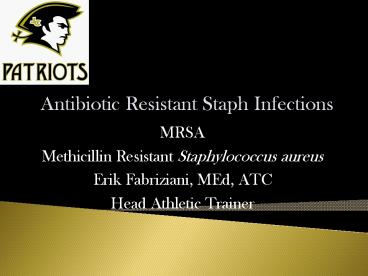Antibiotic Resistant Staph Infections - PowerPoint PPT Presentation
1 / 11
Title: Antibiotic Resistant Staph Infections
1
Antibiotic Resistant Staph Infections
MRSA Methicillin Resistant Staphylococcus
aureus Erik Fabriziani, MEd, ATC Head Athletic
Trainer
2
MRSA History
- Background
- MRSA on rise in athletes
- Documented outbreaks in various settings
- High School
- College
- Professional Sports
3
MRSA What is it?
- Staphylococcus aureus often referred to as
staph - Bacteria commonly carried on skin or in nose of
healthy people - Occasionally will cause infection
- Most common cause of skin infection in US
- Most are minor infections
- Pimples, pustules, and boils
- Red, swollen, painful and have pus or other
drainage - May be confused with insect bites
4
MRSA What is it?
- Most infections can be treated without
antibiotics - Staph can cause serious infections
- Most serious infections were treated with
penicillin based antiobitics - Recently staph has become resistant to these
drugs - The resistant bacteria are called MRSA
- They can be found on the skin, and in the nose of
people without causing illness
5
Transmission
- Staph and MRSA can spread among persons having
close contact (lockerrooms) - MRSA is almost always spread by direct contact
and not air - Spread may also occur through indirect contact by
touching objects contaminated by the infected
skin of a person with MRSA or staph (Towels,
Sheets, wound dressings, clothing, workout areas,
sport equipment)
6
Recognition
- MRSA infections often appear as
- small pustules or boils
- Wounds may be
- Red
- Swollen
- Painful
- Discharge of pus is also possible
- Often misdiagnosed as
- Insect bites
- Ingrown hairs
- Other bacterial infections
7
Seeking Treatment
- Inform the appropriate health care personnel for
active skin infections while at school (school
nurse or athletic trainer) - Early reporting is important
- Seek early care
- Receive proper first aid from appropriate
provider (school nurse or athletic trainer) - Initial evaluation and basic first aid
- Receive appropriate follow up care for suspected
cases (medical doctor) - Wound Care
- Culture wound
- Pharmacological/supportive treatment if necessary
and prescribed by medical doctor
8
Prevention
- Recommendations
- Keep hands clean by washing with soap and warm
water or an alcohol based sanitizer - Immediate shower following activity
- Encourage good hygiene
- Ensure availability of adequate soap and hot
water - Pump soap dispensers with antibacterial soap no
bar soaps - Avoid common whirlpools or tubs if you have open
wounds - Avoid sharing towels, razors, and daily athletic
gear - Avoid cosmetic shaving (males) Care and cover
skin lesions prior to sports participation once
permitted - Any wounds must be covered until healed
- If they cannot be covered the athlete will be
excluded from play - Properly wash athletic gear and towels after each
use
9
Prevention
- Good basic hygiene is important for overall
prevention
10
Web Links
http//www.cdc.gov/ncidod/dhqp/ar_mrsa_ca_public.h
tml8
http//www.webmd.com/skin-problems-and-treatments/
understanding-mrsa-methicillin-resistant-staphyloc
occus-aureus
11
Questions
- Should you have any questions please contact the
nurse or certified athletic trainer for more
information.































